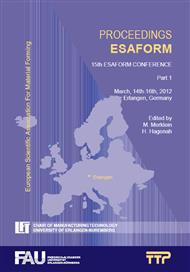p.59
p.65
p.71
p.77
p.83
p.89
p.95
p.101
p.107
Evolution of Roughness on Straining of Interstitial Free – IF Steel Sheet
Abstract:
This study aims to assess the evolution of surface roughness and waviness parameters with plastic strain in Interstitial Free – IF steel sheet. For the achievement of this study, it was considered various roughness and waviness profile parameters such as: arithmetic average roughness (Ra), maximum distance peak-valley (Rt), average waviness (Wa) and waviness of the total height peak-valley (Wt). Tensile test specimens of IF steel at 0º, 45º and 90º to the direction of rolling were fabricated. After preparing the sheet proof specimens, it was performed simple tensile tests and measurements of roughness and waviness of the specimen surface at various strain stages resulting in a large quantity of data. During the tensile test, it has been measured the following plastic strain to indicate the incremental step: (e1) longitudinal strain and (e2) transverse strain. From these data, it was possible to obtain points needed to plot the curves of roughness and waviness parameters versus strain and to determine the material behavior using equations of the equivalent strain. From the curves drawn it was possible to see how the material roughness and waviness behaves during the straining in the uniaxial tensile state, with the possibility to predict the influence of plastic strain on roughness and waviness parameters and the onset of local necking of IF steel sheet. The waviness parameters Wt is the best for characterizing the onset of local necking.
Info:
Periodical:
Pages:
83-88
Citation:
Online since:
February 2012
Authors:
Keywords:
Price:
Сopyright:
© 2012 Trans Tech Publications Ltd. All Rights Reserved
Share:
Citation:


